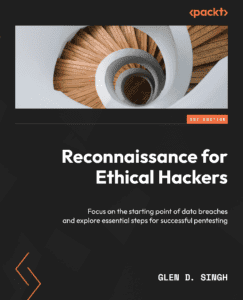Glen D. Singh is the author of Reconnaissance for Ethical Hackers we got the chance to sit down with him and find out more about his experience of writing with Packt.
Q: How did you become an author for Packt? Tell us about your journey. What was your motivation for writing this book?
Glen: A few years ago, one of the awesome persons from Packt Publishing had reached out to me with the opportunity to become an author for their Cisco security solutions book at the time. I was quite nervous and excited about becoming a first-time author as it was something I had not foreseen during my younger years. The opportunity and experience was very thrilling as it enabled me to share my knowledge and experience with others around the world. As time progress, I continue to write more books that focus on helping cybersecurity professionals to identify hidden security vulnerabilities on systems and networks with the intention to help organizations reduce their attack surface while preventing and mitigating future cyber-attacks. My greatest motivation for writing the ‘Reconnaissance for Ethical Hackers’ book is to add more focus on the importance on how cyber criminals are able to leverage publicly available information to improve their cyber attacks on targeted organizations. This book explores real-world techniques and procedures to help aspiring and seasoned ethical hackers and penetration testers to leverage similar strategies and techniques to efficiently discover how their organizations are leaking data and how adversaries can use it to find and exploit security vulnerabilities.
Q: What is the name of your book?
Glen: Reconnaissance for Ethical Hackers.
Q: What kind of research did you do, and how long did you spend researching before beginning the book?
Glen: In my career as a cybersecurity lecturer, I’ve always kept myself up-to-date with the latest trends within the industry to better understand how adversaries are developing new techniques and tools to compromise their targets. These would include understanding the anatomy about some of the latest cyber-attacks and threats, new security vulnerabilities and how researchers are able to create proof-of-concept (PoC) exploits to identify these security flaws on systems. Prior to writing this book, I did a lot of research to determine whether there was a need for this content within the industry and how it was going to help organizations and industry professionals to improve their cyber defenses. Using the information from my research, I carefully designed the outline of this book to ensure anyone is able to get started easily, while using a learner-friendly approach to help beginners gradually develop their skills from beginner to advanced.
Q: What key takeaways do you want readers to come away with from the book?
Glen: The key takeaways will include developing a solid foundation on how adversaries uses reconnaissance to improve their cyber-attack and identify security vulnerabilities on organizations. Additionally, help ethical hackers to gain the skills needed to identify how organizations and people are leaking sensitive information that can be leveraged by cyber criminals and how penetration testers can use the same techniques and procedures as real attackers to identify hidden security flaws and help organizations improve their countermeasures to protect their assets from adversaries.
Q: Can you share any blogs, websites and forums to help readers gain a holistic view of the tech they are learning?
Glen: These are great websites and blogs readers can follow to learn more about new and emerging technologies: https://blogs.cisco.com , www.wired.com , www.theverge.com , www.cnet.com, and https://cisoseries.com.
Q. Did you face any challenges during the writing process? How did you overcome them?
Glen: During the writing process, there was one specific challenge which I had experienced. Sometimes, I would experience “writer’s block” where my mind is unable to develop the words I need to write on topic or even a chapter at times. It was a bit frustrating, because it occurs randomly without any prior signs or warnings, it’s one of the many experiences of being an author, and we all face it from time to time. Whenever I notice I’m unable to think of words to write, I would stop writing and take a break or even go for a walk while taking in some fresh air and grounding myself to nature. This takes away any stress from my mind while clearing my thoughts.
Q. How would you describe your author journey with Packt? Would you recommend Packt to aspiring authors?
Glen: My journey with Packt has always been a wonderful experience. The team of editors and managers were always there to provide guidance and support to me. Packt made the publishing experience very easy and stress-free as there were many behind-the-scene activities which they handled professionally and seamlessly, allowing me to focus more on writing each chapter of my books. I would definitely recommend Packt to anyone who’s interested in publishing their tech books.
Q. Why should readers choose this book over others already on the market? How would you differentiate your book from its competition?
Glen: While there are many amazing books written by many authors around the world, choosing a good book can be tough at times, especially a book that not only teaches you the theoretical content but helps you develop the real-world skills that’s needed for the cybersecurity industry. The ‘Reconnaissance for Ethical Hackers’ book is designed with all learners in mind, not just focusing for seasoned professionals. As a long-time cybersecurity educator, I understood the importance of delivering top-notch learning content in an easy-to-understand method for types of learners and I’ve applied this same effect into this book to ensure it provides great value to the reader. This book begins by introducing the reader to the importance of reconnaissance and how both cybersecurity professionals and adversaries use it to identify vulnerable points of entry in a company. Then, the reader is taken through an exciting journey learning how to apply reconnaissance-based techniques and procedures that are commonly used by adversaries to efficiently collect and analyze publicly available data to create a profile about targeted systems and network infrastructure. Then, you will learn how to set up a sock puppet and anonymize your internet-based traffic to conceal your identity as an ethical hacker to reduce your threat level during reconnaissance assessments. Furthermore, you’ll discover how people and organizations are leaking data about themselves and how adversaries can leverage it to improve their cyber-attacks and threats. Additionally, learn how to leverage Open Source intelligence and common tools to identify exposed systems and networks within organizations, gather leaked employees’ credentials, and perform wireless signals intelligence to better understand how a potential hacker can compromise their targets.
Q. What is/are your specialist tech area(s)?
Glen: My area of expertise is cybersecurity, specially in ethical hacking and penetration testing.
Q. What advice would you give to readers jumping into this technology? Do you have any top tips?
Glen: Everything you read in tech, always try to create a lab to explore the topic while being an out-of-box thinker. Use virtualization technologies to help build a virtual lab environment on your personal computer to gain the hands-on experience and hone your skills. There are so many awesome topics within the field of tech and sometimes it’s a bit overwhelming trying to learn everything all at once. Always try to discover your passion or the fields in tech you enjoy doing the most, then focus your learning path on those specific field(s) and it will help you become an expert in no time.
Q. What’s your take on the technologies discussed in the book? Where do you see these technologies heading in the future?
Glen: The technologies, tools and strategies discussed within this book will always be in demand as they help aspiring and seasoned ethical hackers and penetration testers to identify security vulnerabilities and better understand how their organizations are leaking sensitive information which can lead to a future cyber-attack. As time continues, newer version of these technologies will be created and become available to cybersecurity professionals. However, the fundamental content found within this book will continue to help aspiring ethical hackers and penetration testers to develop a solid foundation on reconnaissance techniques and procedures.
Q. How did you organize, plan, and prioritize your work and write the book?
Glen: The first thing was getting started with the outline of the book as it helps to determine who are the target audience, learning outcomes for the reader, book overview and structure, and the details of each chapter. Understanding who the target audience is important because as a writer you need to understand the mindset, needs and expectations of the readers. Additionally, the learning outcomes was used to determine what the reader will learn after reading each chapter and what skills will be gained after completing the book. Creating meaningful learning outcomes that are needed within the industry improves the value of the book to the reader. Next, developing the book structure helped me create the various chapter heading and sections of the overall book, this provided a visual on the number of chapters, their titles and the order these chapters are listed in the table of contents. Lastly, creating the detail for each chapter such as their description, sub-headings and skills that will be learned at the end of a chapter. Once the outline was developed, it was time to start writing the chapters. While writing chapter 1, I wrote the sub-headings and created multiple key points for each of these sub-headings. After, I started elaborating on each key point and was able write multiple paragraphs to provide a detailed breakdown of each key point. Eventually, from a few key points of a sub-header turned into a few pages of written content. I repeated this technique throughout each chapter and was able to exceed my own expectations along the way to create an awesome book which contains thorough explanations and valuable content.
Q. What are your favorite tech journals? How do you keep yourself up to date on tech?
Glen: Keeping up to date with technology news can be somewhat overwhelming as there are so many new things happening daily in the tech industry. Personally, I subscribe for e-newsletters on various tech websites that provides the top tech news via daily email messages to me. This enables me to quickly read the top news quickly each day and keep up to date without affecting my daily schedule.
Q. Would you like to share your social handles? If so, mention them below.
Glen: Yes, you can find me at:
LinkedIn: https://www.linkedin.com/in/glen-singh,
Facebook: https://www.facebook.com/glen.d.singh,
Instagram: https://www.instagram.com/glen.d.singh/,
X: https://www.twitter.com/glendsingh.
Q: What is that one writing tip that you found most crucial and would like to share with aspiring authors?
Glen: Always create a fully structured outline for your book that contains the specific details of each chapter and their purpose. Within each chapter, create headers based on the topics you want to include as it will help you to develop a smooth flow for your words and content. Setting deadlines for each chapter is good but sticking to those deadlines is better as it helps you to manage your time during the writing process while meeting your objectives. When writing on a topic, breakdown each element of the topic into smaller piece and write on each piece one step at a time. Ensuring each paragraph is simple and very clear to understand by anyone who reads it. Consider there are readers who are new to the topic and without any prior knowledge, simplicity and easy-to-follow methodology works very well with many readers.
You can find Glen’s book on Amazon by following this link: Please click here









